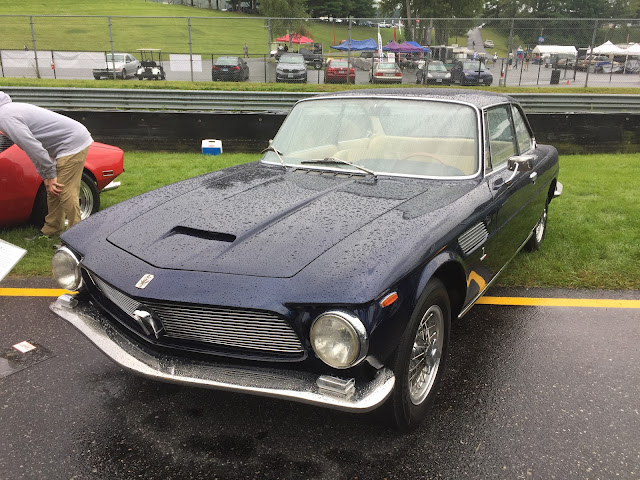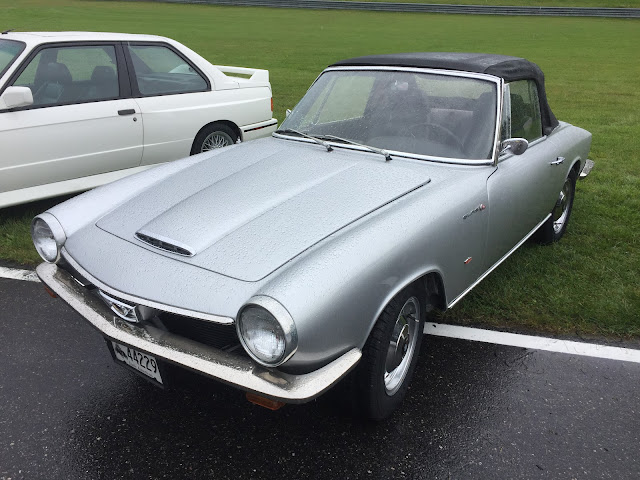This past autumn's Historic Festival at Lime Rock, Connecticut welcomed a collection of vintage, classic and just plain oddball cars that was as deep as it was wide. Mother Nature did not smile upon the event, but despite the rain and the ongoing pandemic, there was a surprising turnout of participants. You're probably beginning to wonder when we're going to tell you something about this mysterious car. It's a 1966 Fitch Phoenix; does that help? Let's start with John Fitch. Born in 1917, Captain Fitch flew P51 Mustangs in WW2 for the U.S. Army Air Corps, and was one of the few pilots to shoot down one of the Luftwaffe's Me262 jet fighters. After the war he helped found Lime Rock Park race track, and raced on the HWM* Alta GP team alongside Stirling Moss. After racing for Cunningham (winning the '53 Sebring 12 Hours with Phil Walters) and Mercedes-Benz, Fitch served as manager and driver for Chevrolet's Corvette SS team at the 1957 Sebring 12 Hours. This led to a good relationship with Zora Arkus Duntov, the head of the Corvette program at GM...

It's easy to forget that Chevy's Corvair prompted lots of interest among car enthusiasts before there was a Ford Mustang, and the 2nd series '65 car with fully independent rear suspension attracted the interest of SCCA racers like John Fitch, who built a series of Corvair Sprints with 4 carburetors and body mods. He then approached GM about supplying engines for a 2 seater GT, and Coby Whitmore designed a body on a shorter 95" wheelbase that anticipated the retro-classic themes of the 70s, with long hood (despite rear engine) and twin front fender spare tire humps, required because the Fitch Phoenix had 2 tire widths, 6" front and 7" rear. Unlike non-Fitch Corvairs, it also had 4 Weber carbs and Girtling front disc brakes. The removable roof panel and recessed rear window also anticipate 70s themes. The original plan was for a fiberglass body, but after Fitch saw the Apollo GT by Intermeccanica, he had Frank Reisner's Italian company body the prototype in steel. Having witnessed the horrific crash at Le Mans in 1955 while racing for Mercedes, Fitch designed the Phoenix with energy-absorbing crash zones. The car weighed 2,150 pounds, had a top speed of 130, and hit 60 in 7.5 seconds. Owing to sales of the front-engined Chevy II, and also to Ralph Nader's success with 1965's Unsafe at Any Speed, Corvair sales slowed greatly after 1966, GM discontinued the Corvair after 1969, and this prototype remains the only Fitch Phoenix. To read more about the HWM cars raced by Fitch and Moss, please see our post "Forgotten Classic: Racing into Obscurity on Alta & Chevy Power" (11-23-20). The Corvette SS appears in "Forgotten Classic: Chevy's Corvette SS Ran Before the Ban" (7-18-20). And for a history of Intermeccanica, see "The Etceterini Files Part 28: Intermeccanica" (1-12-22). Also, a subscriber who knew John Fitch wrote to fill in more detail on the man's accomplishments. See the Postscript for that...
This Vignale-bodied Cunningham C3, built 1953-'55, was Briggs Cunningham's effort to convince race organizers that his C2, C4R and C5R road racers were related to a production car, and also to generate some funds for his efforts to win Le Mans with an American car. Cunningham's 10 racers were bodied in Florida, but the C3 road cars (of which there were 19 coupes and 9 convertibles) were on a longer chassis with Italian bodies designed by Michelotti. Excepting a Cadillac-powered C1 and Meyer Drake-powered C6R, all Cunninghams were powered by the Chrysler 331 hemi V8. For more detail on the Cunningham GT and road racing cars with a photo essay, you could see our blog archives for "A Moment Too Soon: The Cars of Briggs Swift Cunningham" (4-15-17).
The Alfa Romeo P3 put that company on the map in the racing world and beyond, in the same way the Type 35 had done the trick for Bugatti a few years earlier. The car was Alfa's second monoposto racer, but their first GP single-seater. Introduced midway in the 1932 season, the P3 would eventually win 46 races. Under the hood is the Vittorio Jano-designed dual overhead cam straight eight composed of two 4-cylinder blocks, with twin Roots-type superchargers. Jano steadily improved the car over its life; engine displacement increased from 2.65 liters to 2.9 liters in 1934, and again to just under 3.2 liters in 1935, the year Alfa introduced independent front suspension. Drivers included immortals like Nuvolari, Chiron, Varzi, Campari and Biondetti. And running the Alfa racing team was a guy you may recall: Enzo Ferrari. For more on Alfa Romeo in the 1930s, you could have a look at our post on "Alfa Romeo's Genius Bar: Jano, Anderloni, Figoni & Zagato" (10-3-19).
Albrecht von Goertz designed the 4-passenger BMW 503 along with the more famous 507 two-seater, and both cars went into production in spring of 1956. Goertz gave car the low, lean proportions of contemporary Italian designs, yet reinforced the BMW identity by retaining the traditional vertical twin-kidney grille. That grille is missing on this example because the original owner took it to Ghia Aigle (Ghia's Swiss offshoot) to be remodeled after a front-end collision. The 503 coupe and cabriolet shared their 3.2 liter V8 with the 507, and stayed in production into 1959. To read more in our posts on the 503 and 507, see "That Other Five Series: BMW's Baroque Angel Led to 503 and 507" (10-20-19).
If the car below were part of a quiz as to its origins, the ostrich-skin interior might have you guessing "French", especially because most upper-crust French cars in the classic era had right hand drive like English cars...
But you'd be wrong; it's a Jaguar SS100, introduced by William Lyons and his SS Cars (that name changed after WW2) in 1936, and made until 1939 in 2.66 liter form (called the 2-1/2 Liter, 191 examples made) and starting in 1938 as a 3.5 liter (116 examples). The sweeping fender line and fold-down windshield make for a dashing profile, and the 3.5 liter offered plenty of performance with a claimed 100 mph at a reasonable price, part of the Lyons formula that would allow Jaguar to take a lion's share of the postwar performance car market. Inline six cylinder engines were based upon Standard Motor blocks, but with overhead valve Jaguar heads.
As with many British cars of the era, Lucas headlights play a powerful part in a composition of separate elements including the radiator and its steel braces, the central fog light, and the flowing fenders. As memorable as it was un-aerodynamic... To read more on the SS100 and predecessor SS90 in our blog series, see "Forgotten Classic: Jaguar's SS100 Coupe" (4-19-20).
Iso Rivolta first moved from making refrigerators into making cars with the Isetta bubble car, later licensed to BMW, in the early Fifties. By 1962 they were offering this Bertone-bodied GT designed by G. Giugiaro. Power was supplied by a Chevy 327, and four-wheel disc brakes and a De Dion rear supsension rounded out a chassis designed by Giotto Bizzarrini. Nearly 800 of these cars were built before production ended in 1970. To read more of the Iso story, see "Born From Refrigerators: Iso Rivolta" (10-20-18)
Two more American-engined Italian designs hunkered down in the rain, both penned, like the Iso, by Giugiaro. The early Sixties Chevy-engined Gordon Keeble GK1 in the foreground was designed for a British concern and bodied by Bertone; the better-known late-Sixties DeTomaso Mangusta behind it was Ford-powered and built by Ghia.
All of the 100 Gordon-Keebles built from 1964-'67 were equipped with right hand drive. None were exported to the US back then, but the car has gained a following, because the 1960 GK1 prototype was a trend-setter. To read more on the Gordon-Keeble, see our post "Forgotten Classic: Gordon Keeble---Sign of the Turtle" (12-6-21)
Another Italian body design on display was by Pietro Frua, who had bodied various custom and production Maseratis when he cooked up this charmer for Germany's Hans Glas, the father of the Goggomobil. By 1964 Glas had moved upmarket with this GT in 1300 and 1700cc displacements. An innovative toothed fiberglass belt operated a single overhead cam on the inline four. Just over 5,000 Glas fastback coupes were built by 1967; these cabriolets, however, are very scarce.
In mid-1967 BMW gobbled up the firm because it needed the production capacity; this move also conveniently eliminated a potential competitor for their Neue Klasse sedans and coupes. This led to a brief period of BMW-badged and engined Glas GT coupes, and a Glas V8-engined BMW 2+2. You can read more about this story in "Forgotten Classics: Frua Designs for Hans Glas and BMW" (12-2-18).
Below we see one of no more than 7 Bugatti Type 59s built as a GP racing version of the 3.3 liter, twin cam straight eight Type 57. These were campaigned with little success in 1934 and 1935, because the better-funded efforts from Alfa Romeo and especially Mercedes and Auto Union had eclipsed Bugatti's engineering efforts, mostly with more sophisticated suspension and braking, and early efforts at aerodynamics. These Bugattis are lovely, though, with their cubist-influenced engine externals showing off sharply defined geometry. The piano-wire wheels were a signature feature, with the non-structural wires employed for centering, and the alloy hubs providing strength.
A closeup of the famous solid front axle with leaf springs passing through it reminds us that despite some pretty advanced notions about engine design, Ettore Bugatti was reluctant to fully embrace the 20th century in other areas. The Type 59 had mechanical brakes as well as solid axles front and rear. But many observers would agree that it still has buckets more charm than its 21st century, high technology namesake...
Postscript: Subscriber Keith Carlson was a friend of the late race driver and inventor John Fitch, and wrote to mention what an entertaining dinner companion he was, and to note the many patents Fitch held for his safety-related inventions. These included those familiar yellow, sand-filled plastic barrels you've seen at freeway off-ramps known as Fitch Barriers, a displaceable guardrail that would redirect cars along the rail instead of the traffic stream, a compression barrier for oval racetracks, and a driver capsule to prevent neck injuries in races. Fitch crashed 8 cars into his patented barriers at highway speeds to demonstrate their effectiveness during tests, and also patented a steering system for hot air balloons...
Photo Credit: All photos were generously supplied by the photographer, LCDR Jonathan D. Asbury, USN.
















No comments:
Post a Comment